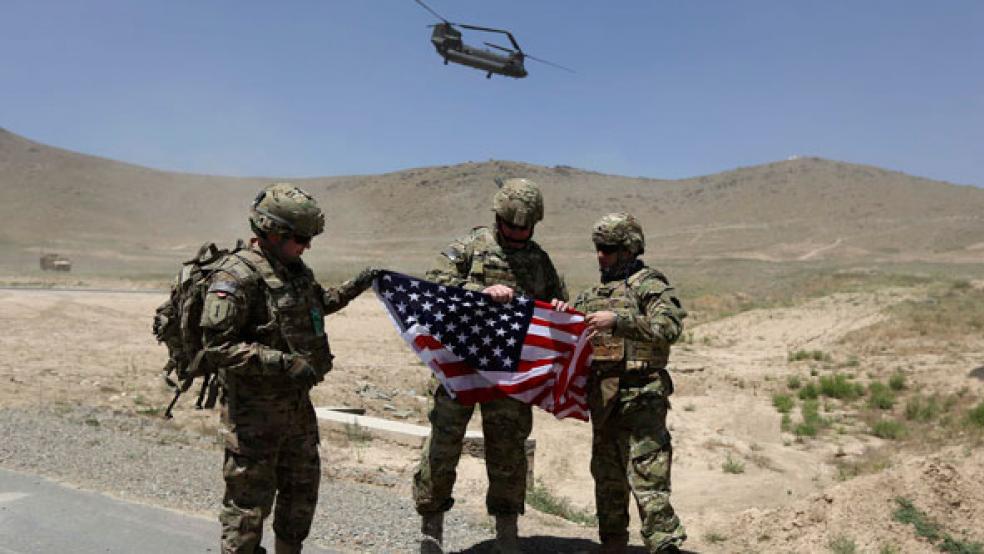The White House has made yet another move in the ongoing game of poker with Afghan President Hamid Karzai Tuesday, with officials putting a new option on the table for American troop presence: 3,000 based at Bagram Air Force Base and Kabul.
The newest offering, which sounds more like a decision, is the fourth time the Obama administration has tried to close a deal and extricate most U.S. troops from Afghanistan. Other attempts include:
Related: Hagel Picks a Fight with the Pentagon, Congress
- The 10,000-troop option would keep American troops in Kandahar, Kabul, Bagram and Jalalabad until the end of next year. Some 5,000 NATO and other international troops would be based in western and northern Afghanistan as part of a NATO mission called Resolute Support.
- The second option is to leave somewhere between 10,000 and 3,000 troops in Kabul and Bagram until 2016. The troops would advise the Afghan military as needed.
- The 3,000 troops option is number three, with military restricted to Kabul and Bagram, according to officials who spoke to The Washington Post on the condition of anonymity. Drones could leave the base, but troops would not, and it’s not clear how long they’d stay.
- The final option is called the zero-option: complete withdrawal of all U.S. forces. Without U.S. forces in Afghanistan, allies like Italy and Germany would also exit, leaving no international military presence.
Related: Hagel Puts Military on Alert: Big Cuts Are Coming
Which option is best depends on your perspective: the military wants to protect the gains it made there with 10,000 troops. The State Department wants troops to have the ability to leave their bases to supervise and protect development projects. The White House seemingly wants as few troops in Afghanistan as possible. And the American people simply want the war to end. Gallup determined last year that for the first time since the war began, the number of Americans who thought the war wasn’t worth it equaled the number of Americans who did.
The repercussions of the older options have been analyzed, but the new option has not. Here are three questions that need to be answered to determine if the plan is viable.
1. Can troops fight back? In a country the size of Afghanistan, 3,000 troops is a small number. And it’s already known where they would be stationed--Kabul and Bagram Air Base--and how many of them would be there. The troops are sitting ducks. Would they be able to defend themselves if fired upon? Could they leave the base to pursue their attackers?
Related: One Injured Soldier of War Costs the U.S. $2 million
2. Is it worth putting their lives at risk? American troops would simply be there as a show of force; they wouldn’t really be doing anything to advance American interests or protect hundreds of billions of dollars worth of development projects. According to the Special Inspector General for Afghan Reconstruction, few of these projects are likely to succeed anyway. Why put more American lives at risk if there’s nothing to gain? This is the argument being made by Sen. John McCain (R-AZ)
“If it’s a smaller and smaller number, if you get below 10,000, plus 3,000 or 4,000 NATO troops, then it’s not worth it because you can’t carry out those missions that are necessary," McCain said. “It has to be a large and capable force, which will make a difference to help them prevail over a continuing war. Otherwise it will turn out like Iraq has where the black flags of al Qaeda are now flying over the city of Fallujah.”
3. Would these troops actually be spies? Right now, the CIA, with the military’s protection, handles human assets around Afghanistan. This would change under all options but number one. Under the new option, the military would be in charge of collecting intelligence.
This kind of work requires a different kind of soldier, and DOD has long wanted to get in on the spy game. According to Mohammad Daud Miraki, an Afghan activist, writer and politician, this is exactly what the Pentagon is trying to do.
“If they think the presence of 3,000 troops is enough to enhance Afghan forces – that doesn't make sense,” Miraki said in an interview with Russia Today. “It’s very likely that they may have these 3,000 troops only for intelligence purposes, for a larger agenda that they have at hand, maybe [concerning] Russia, China, or some other purpose.”
Top Reads from the Fiscal Times:





